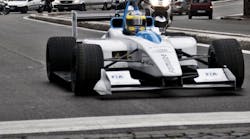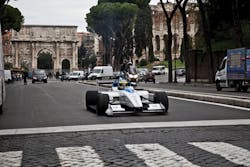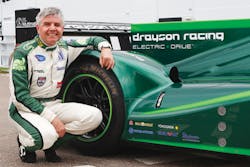Could an electric car someday run at Indy? It’s a distinct possibility judging by developments in Formula 1 racing. Starting next year, all-electric cars will have their own racing class running under the auspices of the Fédération Internationale de l’Automobile (FIA), the same organization that handles Formula 1 racing.
FIA will stage the races on the streets of major cities rather than on closed tracks. The first race is expected to take place in a yet-unnamed European city. FIA says it is also talking to cities in both the U. S. and South America about hosting Formula E races.
Formula E cars will be able to hit top speeds in the 200-mph range just like their combustion engine-powered cousins. But battery limitations force the race format to be a little bizarre. After 20 min of competition, each driver will hop out of their car and jump into another with a fresh battery to continue the race. Meanwhile, the first car will get recharged. After another 20 min of racing, drivers hop back into the recharged cars for 20 min to take the checkered flag.
There are critics of this Chinese firedrill-style setup who claim such a format will make it hard for fans to take the whole thing seriously. A more-important criticism is that the need for each racing team to own two cars makes Formula E an expensive endeavor. Plans are for races to host 20-car fields which would actually be 40-car fields with half the cars charging at any given time.
But the concept of an electric-vehicle race series has already attracted entries. Drayson Racing Technologies in the U. K. is the first team to commit to the new Series. It has developed a prototype Formula E racer which may serve as the model for cars in the 2014 season. (FIA plans to make the races spec-class events next year, meaning all cars will be roughly the same. Formula E will then revert to an open class in 2015 and thereafter.) Drayson has already designed an 850-hp LeMans-style electric car that set a speed record for E vehicles (and placed 11th overall) in a U. K. hill-climb event.
Drayson officials don’t think the format of Formula E will detract from the excitement of the event. "The cars sound a little like the Millennium Falcon in the Star Wars movies," says Paul (Lord) Drayson, managing partner of Drayson Racing. "It is a high-tech sound, not like the screaming you get from a racing engine. From the point of view of putting on a show, I think it will be particularly good for younger fans."
Drayson, whose team has acted as a scientific adviser to the FIA Formula E Championship during its initial planning, says the race cars will also serve as development platforms for E-vehicle technology. "Race rules are set up to emphasize the electric drivetrain rather than the aerodynamics," he emphasizes.
One technology that could get a boost from Formula E is inductive charging. Drayson foresees wireless charging tracks being embedded in the streets of cities hosting Formula E events such that race cars could recharge as they pass over designated portions of the course.
Once the race is over, the tracks could serve as prototypes for a recharging infrastructure aimed at ordinary E-street vehicles. "This scheme would free cars from the constraints of the battery. We see this as a way motor racing can pioneer this technology," he says.
In that regard, the Qualcomm Inc. subsidiary Qualcomm Europe Inc. will sponsor Drayson Racing in Formula E to help develop wireless-charging technology. The charging system uses Qualcomm Halo Wireless Electric Vehicle Charging (WEVC) technology. Drayson Racing has been evaluating a specially developed version of the system that is rated at 20 kW. The charging system was part of Drayson’s prototype that earned honors at the hill-climbing event.
The plan for these wireless-charging systems is to recharge moving cars, not just those sitting in the pit. Once the race is complete, the inductive-charging equipment and charging tracks embedded in racecourse roadways will stay in place to help advance recharging infrastructure for ordinary EVs.
Moving to that goal, inductive chargers that recharge vehicles sitting still are in the early commercialization phase. According to Anthony Thompson, vice president of business development at Qualcomm, the next step is semidynamic charging where a vehicle moves slowly while recharging. The scenario Thompson envisions is that of taxis recharging while crawling along in a passenger pickup lane. Next will come fully dynamic charging where vehicles zip along while getting more juice. Thompson says the R&D for such systems is in full swing.
"The goal is to approach power-transfer efficiency from grid to battery that static systems now realize, which is about 90%," says Thompson. "We think that figure can be achieved within certain operational constraints. We also hope to realize full power transfer even if the car is 8 inches to either side of the power track."
Unfortunately, a lot of the technical details about the Formula E cars are either yet to be determined or have not yet been made public. Drayson officials say the type of motor that will power the cars has been determined but its specifications have not been released. Similarly, the Formula E battery supplier has yet to be announced.
Electric motors for the Series will come from McLaren Electronic Systems Ltd., which supplies electric-control units to all Formula 1 teams. McLaren will also be supplying the transmissions and control electronics for the cars. The cars themselves will be built by a European company called Spark Racing Technology.
And once these cars take to the track, the experience is shaping up to be interesting not just for the fans but for drivers as well. "The cars will have a lot of power, given their weight. There will be a lot of oversteer and the courses are likely to be challenging for the drivers," says Paul Drayson. "And because they are racing on city streets, there will be concrete walls all around, so the driving experience will be quite intense. Plus, these are all-new courses which drivers will have little time to learn. That will put a premium on the ability to quickly become familiar with the layout so you can put in a fast time."
Resources:
Drayson Racing Technology, http://www.draysonracingfe.com/
Formula E blog, http://formula-e-news.com/
Qualcomm Halo, http://www.qualcommhalo.com/



